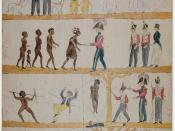Watching the film "Rabbit-Proof Fence" directed by Phillip Noyce, before reading the play No Sugar by Jack Davis, strengthened my understanding of the Assimilation Policy, Aboriginal culture, the unfair treatment of Aboriginals by the white citizens and white supremacy and control over Aboriginals. I believe that if I hadn't seen the film before reading the stage drama, I wouldn't have developed an adequate understanding of Aboriginals, or had such a sympathetic reaction to the Millimurra family in No Sugar. The introduction of the Moore River Settlement in the film made it easier for me to picture it, and see the awful and obviously uncomfortable situation the Aboriginals were placed in. The camera angles and characters in the film and stage drama help to deepen my understanding of Aboriginals, their culture and the extent of the white supremacy and control over Aboriginals.
The Assimilation Policy is an atrocious part of Australian history.
It took place in the 1930s, and gave the government permission to take young half-caste children away from their families to learn how to live a white, Christian life. Before watching Rabbit-Proof Fence, I had some idea of this, and through viewing the film I witnessed the intense fear of the Aboriginal children and formed a greater understanding of the matter. Mr AO Neville is a character present in both the film and the play, and is the so-called 'Protector of Aboriginals.' The use of camera angles in the film shows that Neville is without a doubt an evil character who appears to have superiority and control over the Aboriginals. During the start of the film, a close-up of a white man on a horse is shown. The shot scans over the man's boot to create suspense and fear, and makes its way up to his...



Rabbit-Proof Fence - The Assimilation Policy
Having studied Australian History last year at school, I found that this essay complemented the knowledge I had already gained. The "Lost Generation" is a black mark in Australian history, and it should never be forgotten. In this film, the Australian Indigenous people are indeed portrayed through one Aboriginal family. And Camera angles are certainly used to convey the emotion and horror of the Assimilation Policy. The actors should be well applauded for their outstanding acting skills, drawing emotion from the viewer.
1 out of 1 people found this comment useful.